
Many millions of years ago, long after the great reptiles had colonized the land, some of them decided to return to the sea. Today, marine reptiles are not the most common residents of the coral reef, but they are definitely among the most beautiful. Perhaps the most well known reptiles in this group are the sea turtles. There are many different species of sea turtle, ranging in size from only 2 feet to the real giants at over 6 feet in length. Sea turtles lay their eggs on land. They can be seen on the beaches late at night digging a deep hole in the sand. The eggs are deposited and covered over. Several months later, the tiny turtles dig their way to the surface and scramble towards the sea. But a turtle's life is not easy. Only one in a thousand will survive the predators and return to the beach one day. Sea turtles were once killed by the thousands for food. Today, even though many face extinction they continue to be exploited. Their eggs and shells are in constant demand the world over. Another member of the sea reptile family enjoys full protection. The sea snake is the most venomous snake on Earth. Several sea snake species can be found swimming the world's coral reefs. Some of them are spectacularly colored. Divers are weary of this animal, but the sea snake is timid and will not attach unless provoked. Below is a list of some of the more common reptiles found on the reef.
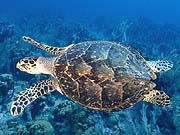
The hawksbill turtle gets its name from its hawk-like beak. It ranges in size from 30 to 36 inches in length. This turtle's shell is the source of "tortoise shell", and because of this commercial exploitation has caused their numbers to dwindle. Their shell and oils are in constant demand, placing this turtle in danger.
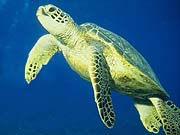
The olive ridley gets its name from the olive color of its shell. This turtle is the smallest of the sea turtles, ranging from 24 to 30 inches in length. Like the hawksbill, this turtle is also in danger from over exploitation. The United States lists this turtle as an endangered species. Their eggs and meat are highly prized in Japan. They are common in most of the world's oceans, where they are often killed in shrimp trawls and gill nets. The lucky ones live about 50 or 60 years.
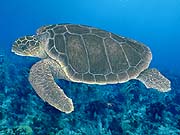
The loggerhead is a large reddish-brown turtle. They range in size from 33 to 40 inches in length. Loggerheads are the most common sea turtles found in the southeastern U.S. They feed on crabs, mollusks, and jellyfish. The biggest danger to this species is pollution and commercial fishing. Loggerheads nest in the spring, where an average female will lay between 100 and 125 eggs.
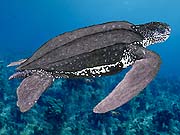
The leatherback is the largest of the sea turtles. They can reach a length of 6 feet, making them the true giants of the undersea reptiles. These turtles get their name from their shells. Unlike the other turtles, the Leatherback's shell has no scales. Instead it is covered with a rubbery leather-like skin. These turtles can be found in many of the world's oceans.
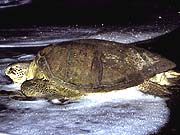
The green sea turtle can be recognized by the radiating pattern on its shell. This is a medium sized turtle ranging in size from 36 to 43 inches in length. Green sea turtles are commonly found in the waters off the coast of Florida. Due to their declining numbers, steps are being taken to protect their nesting areas on Florida beaches. These turtles eat mainly sea grass and algae, which gives them their green color.
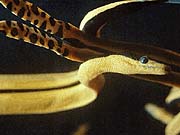
Sea snakes can be found inhabiting most coral reefs of the world. They differ from terrestrial snakes in that their tails are flattened to form a paddle. This helps to propel them through the water. Even though sea snakes are extremely poisonous, they are not aggressive and rarely bite humans. There are over fifty species of sea snakes, which can be found throughout the tropical regions of the Indian and Pacific Oceans.
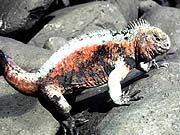
Although not a true marine reptile, the marine iguana spends a considerable amount of time in the water. These reptiles represent a unique evolutionary turn. They live exclusively in the Galapagos Islands off the coast of Ecuador. Several evolutionary adaptations have enabled these lizards to dive and spend time underwater. They do this to feed on the abundant algae that grow on the underwater rocks.
Sponges & Sea Squirts | Corals & Anemones | Sea Worms | Echinoderms
Crustaceans | Mollusks | Coral Reef Fishes | Unusual Reef Fishes
Sharks & Rays | Marine Reptiles | Marine Mammals